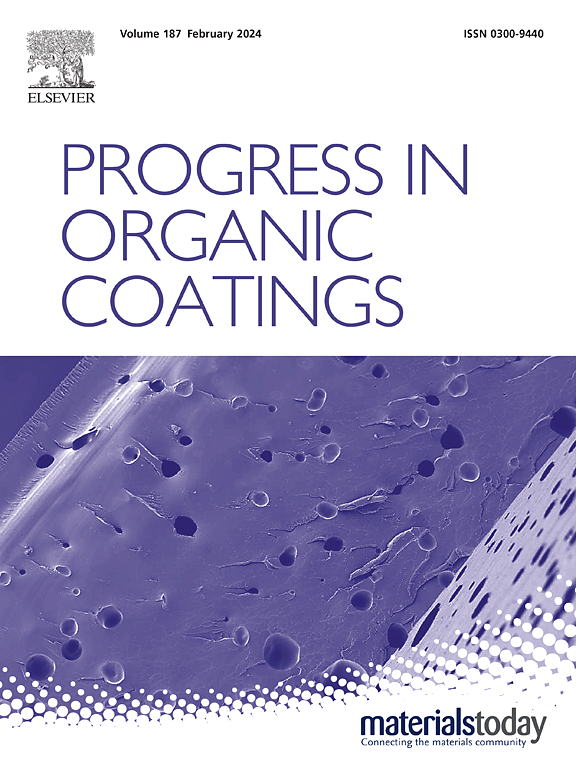没食子酸改性蒙脱土增强丙烯酸乳液复合涂料:通过屏障和界面钝化增强机械和防腐性能
IF 7.3
2区 材料科学
Q1 CHEMISTRY, APPLIED
引用次数: 0
摘要
为了减少全球每年因腐蚀造成的超过1万亿美元的经济损失,本研究开发了一种多功能防腐复合涂层,将没食子酸改性蒙脱土(D-MMT)掺入丙烯酸乳胶(AL)基质中。通过离子交换合成的D-MMT层间距显著扩大(从1.270 nm增加到1.680 nm),并增强了聚合物内部的分散性。在最佳负载为4 wt%时,涂层表现出优异的机械性能-硬度增加(从B级到HB级)和耐磨性-以及热稳定性改善(分解温度从360°C提高到380°C),这归功于树脂和纳米填料之间的氢键。电化学分析表明,在3.5 wt% NaCl中浸泡35天后,低频阻抗模量达到108 Ω·cm2(比纯AL高两个数量级),腐蚀电流密度从2.307 × 10−7降至2.343 × 10−9 A/cm2。XPS和FESEM-EDS分析揭示了损伤后界面钝化保护机制,通过没食子酸的螯合还原作用,形成致密的钝化层,有效地阻断了活性腐蚀部位。由于没食子酸的强还原和螯合能力,损伤部位的Fe2+离子富集(58.3%),铁含量降低(29.9%,AL为74.81%)。这项工作为设计具有集成屏障、机械和自愈功能的涂料提供了一种可扩展的策略,可用于工业应用。本文章由计算机程序翻译,如有差异,请以英文原文为准。
Gallic acid-modified montmorillonite reinforced acrylic latex composite coatings: Enhanced mechanical and anticorrosion performances via barrier and interface passivation
To mitigate the global economic loss exceeding $1 trillion annually from corrosion, this study develops a multifunctional anti-corrosion composite coating by incorporating gallic acid-modified montmorillonite (D-MMT) into an acrylic latex (AL) matrix. The D-MMT, synthesized via ion-exchange, exhibited a significant expansion in interlayer spacing (from 1.270 nm to 1.680 nm) and enhanced dispersion within the polymer.At an optimal 4 wt% loading, the coating exhibited superior mechanical properties-increased hardness (from grade B to HB) and wear resistance-along with improved thermal stability (decomposition temperature elevated from 360 °C to 380 °C), attributed to hydrogen bonding between resin and nanofillers. Electrochemical analysis demonstrated exceptional corrosion protection, with low-frequency impedance modulus reaching 108 Ω·cm2 (two orders higher than pure AL) and corrosion current density reduced from 2.307 × 10−7 to 2.343 × 10−9 A/cm2 after 35-day immersion in 3.5 wt% NaCl. XPS and FESEM-EDS analyses revealed a post-damage interface passivation protection mechanism via gallic acid-mediated chelation-reduction, forming a dense passivation layer that effectively blocked active corrosion sites, evidenced by enriched Fe2+ ions(58.3 %) and reduced iron content (29.9 % vs. 74.81 % in AL) at damaged regions due to the strong reducing and chelating capabilities of gallic acid. This work provides a scalable strategy for designing coatings with integrated barrier, mechanical, and self-healing functionalities for industrial applications.
求助全文
通过发布文献求助,成功后即可免费获取论文全文。
去求助
来源期刊

Progress in Organic Coatings
工程技术-材料科学:膜
CiteScore
11.40
自引率
15.20%
发文量
577
审稿时长
48 days
期刊介绍:
The aim of this international journal is to analyse and publicise the progress and current state of knowledge in the field of organic coatings and related materials. The Editors and the Editorial Board members will solicit both review and research papers from academic and industrial scientists who are actively engaged in research and development or, in the case of review papers, have extensive experience in the subject to be reviewed. Unsolicited manuscripts will be accepted if they meet the journal''s requirements. The journal publishes papers dealing with such subjects as:
• Chemical, physical and technological properties of organic coatings and related materials
• Problems and methods of preparation, manufacture and application of these materials
• Performance, testing and analysis.
 求助内容:
求助内容: 应助结果提醒方式:
应助结果提醒方式:


